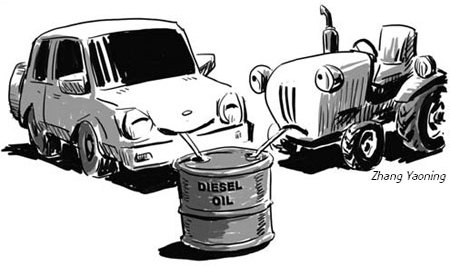
|
OPINION> Commentary
 |
|
'Clean' diesel cars may worsen air pollution
By Masaru Sagai (China Daily)
Updated: 2008-12-04 07:53 With recent advances in diesel engine technology, Nissan Motor Co in September released Japan's first diesel-powered passenger car that meets the latest domestic emission control standards, to be implemented in 2009. Positioning it as a "clean diesel car", the industry, environment and transport ministries and industrial organizations in July decided on a plan to promote sales of such environmentally friendly diesel-engine vehicles. The promotional measures include providing subsidies to buyers and encouraging government offices to introduce such cars for official use. But are diesel-powered cars really clean? Emission standards cap per-vehicle emissions of particulate matters (PMs) and nitrogen oxides (NOx). PMs are carcinogenic and known to trigger asthma. NOx also aggravates symptoms of asthma. Regulations have been strengthened gradually and under new 2009 standards, PMs will be reduced drastically by 60 percent and NOx by 40 percent from current levels, respectively. The government says since the emissions of carbon dioxide (CO2) are 20 to 30 percent lower than those of comparable gasoline-engine vehicles, clean diesel cars contribute to the fight against global warming. Because of their dirty image among consumers, however, diesel passenger cars were highly unpopular and made up only 0.04 percent of total domestic sales of passenger vehicles in 2005. Nevertheless, the government is calling them clean and trying to bring them back in cooperation with automakers hoping to expand the diesel car market. But it is highly questionable whether improved diesel cars are in fact clean. For one thing, incomplete combustion is unavoidable with diesel engines, and could be a fatal defect. The high-pressurized fuel injection systems improved combustion efficiency of diesel engines. As a result, PMs are released in the form of a fine mist and black fumes have seemingly disappeared. In exchange, however, the level of invisible ultra-fine nano-particles of less than 0.1 micrometer in diameter rose more than several tens of thousands of times. A micrometer is one-millionth of a meter. In short, the particles only became finer and invisible to the naked eye.  It is known that PMs measuring several micrometers can enter the respiratory system and trigger illnesses such as asthma. But nano-particles pass through the respiratory system and enter blood vessels. Furthermore, recent animal tests have proved that they even reach circulatory organs including the heart, as well as the brain, nerve and reproductive systems. A joint research team from the Tokyo University of Science and an institute of clinical pathology in Tochigi Prefecture had pregnant mice inhale diesel fumes and proved that nano-particles invade the brain of fetuses. Epidemiological surveys in the United States and Europe revealed that nano-particles raise the incidence of heart disease and death rates in humans. The United States and other countries have set environmental standards for particulate matters measuring 2.5 micrometers or less (PM 2.5). If US standards were applied to Japan, pollution levels measured at most survey points along main roads would exceed them. At the National Institute for Environmental Studies and universities, we have conducted animal tests in which we cultivated cells that cover the surface of blood vessels and respiratory tracts. When nano-particles were mixed with the cells in the test tube during the cultivation, we confirmed that a large number of the nano-particles entered the cells and caused them to die. The second point is that even when stricter regulations are enforced on diesel cars, in fact, gasoline-engine cars are far more environmentally friendly. Gasoline-powered cars emit limited levels of nano-particles and larger PMs. Thanks to advanced emission control technology, NOx emissions have also been reduced to far less than one-tenth of government emissions standards. If gasoline cars are replaced by diesel cars, invisible air pollution by nano-particles will drastically advance. The third point is that diesel cars will not offer a solution to environmental and energy problems. Instead of promoting diesel cars, the government should focus more efforts on spreading use of gas-electric hybrid vehicles and electric-motor cars and eventually pave the way for vehicles powered by renewable energies, such as fuel-cell battery vehicles. Since last year, the Environment Ministry has been studying to establish new environmental standards for PM2.5. But the work is making slow progress and the spread of clean diesel cars will not encourage the government to introduce new regulations. The government and the Environment Ministry should actively advance research on the harmful effects of nano-particles on human health and establish environmental standards to ensure the safety and security of citizens. The author is a former visiting professor at the Aomori University of Health and Welfare The Asahi Shimbun (China Daily 12/04/2008 page9) |